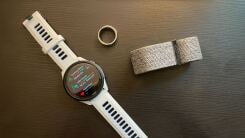How Oura, Whoop, and Garmin Compare on Measuring HRV

Heart rate variability is an excellent metric for measuring how much stress your body is under. Many wearables can record your HRV overnight and give you the data in the morning, alongside your resting heart rate, another useful number. But which device does that best? I wore three different devices to bed for three weeks to see how they compare, and the results were surprising.
The devices I tested were an Oura ring (gen 3), a Whoop 4.0 band and a Garmin Forerunner 265 smartwatch. (Full review of the Forerunner coming soon, by the way. Spoiler: I like it.)
$299.00
at Best Buy

$299.00
at Best Buy
$239.00
at Amazon


$239.00
at Amazon

$449.00
at Amazon

$449.00
at Amazon
What is HRV, anyway?
HRV, or heart rate variability, is a measure of how steady your heartbeat is. Not how fast or how slow, but how different a timeframe passes between beats. The differences are only measurable with precise equipment, but here’s the basic idea: If your heart goes “beat…beat…beat………..beat…beat..beat…….beat,” you have a high HRV, and that’s a good thing. On the other hand, if your heart goes “beat….beat….beat…beat…..beat,” that’s a low HRV. We tend to have a low HRV when we’re stressed or fatigued, and a high HRV when we’re either not stressed, or recovering well from our stressors.
This may seem counterintuitive, because most of us think of an ideal heartbeat as being steady and regular, but subtle variations from one beat to another are healthy and normal. Our heart takes its orders on how fast to beat from two different parts of our nervous system (sympathetic and parasympathetic). It’s thought that a high HRV indicates that the two systems are both active—balancing each other out, in a sense.
Your HRV will change from day to day, and that’s where these devices come in. You’ll often see a change in your HRV numbers right after a hard workout or stressful work day, giving you an early heads up about what your body is dealing with. This information, used wisely, can help to guide your workout schedule and your health-related habits.
What counts as a “good” HRV depends on your own history; it’s not worth comparing yourself to others. (I don’t mean that in a feel-good kind of way, but literally, scientifically: your HRV only makes sense when compared to itself.) Whoop reports that the middle 50% of 20-year-olds have an HRV between about 60 and 105, with numbers declining as we get older. If you’re 60, according to that data set, you’re likely to have HRV numbers somewhere between 30 and 50.
How does HRV differ from resting heart rate (RHR)?
Your resting heart rate is also a number that reflects stress on your body, including fatigue and illness. Unlike HRV, a higher resting heart rate means you’re more stressed, and a lower one is a sign that you’re well recovered.
Resting heart rate can also change over time as you become more fit. Athletes tend to have lower RHR numbers, and people who take up an exercise habit often find that their RHR declines a bit over time. (That said, RHR isn’t a direct measure of cardio fitness; there seems to be a significant genetic component as well. Take me as an example: my RHR is always pretty low, even when my cardio fitness is crap. If I’m doing a lot of endurance training, it will drop by two to three points, but no more.)
Most healthy adults have a resting heart rate of between 55 and 85 beats per minute (some sources give 60 to 100 as the typical range). It’s important to note that these numbers usually assume that you’re sitting quietly in a doctor’s office. When you’re asleep in your own bed, your heart rate can dip a bit lower. So it’s normal to see lower numbers than these on a wearable that records all night.
How to track your HRV and resting heart rate with wearables
Gone are the days when you may have charged your fitness tracker at night; now, fitness-focused wearables are expected to be worn in your sleep to track these nighttime metrics.
During the night, your device monitors your heartbeat. It may sample and average different readings, and each device measures and calculates its numbers slightly differently. (That’s why I didn’t expect much agreement between the devices, but more on that in a minute.) When you wake up, you might be presented with a “readiness” or “recovery” score, but I stand by my position that HRV and RHR are the only numbers really worth paying attention to (aside from time in bed, if you want to monitor your sleep).
The data will be presented to you in the device’s companion app or, in the case of devices with a screen, on the device itself. Often the app or device will tell you how your numbers compare to your usual. What you do with that information is up to you.
How I gathered my data
For this experiment, I wore my three devices to bed every night.
-
I own the Oura ring and wear it every night whether I’m writing about it or not. I’m very used to the numbers I see there. I wore it on my left ring finger.
-
The Forerunner 265 went on my left wrist. I’m testing it out with plans to review all its features soon, so it was natural to wear it to bed and see how it compares to the numbers I’m used to from Oura.
-
Finally, I added a Whoop band to the mix. I don’t normally wear this (unless I’m writingaboutit) and for this experiment I only wore it at night, not during the day.
I entered each day’s resting heart rate and HRV from each device into a spreadsheet. Whoop and Oura each give one number as my nightly HRV; Garmin gives two, an “overnight average” and a “highest 5-min average.” So for that device, I tracked both. I wore the Oura and Garmin for about a week before realizing I should add the Whoop to the mix. In total, I wore at least two devices for about a month, with 24 days of data on all three.
When it comes to using this data, I already have a sense of how the numbers compare to my experience. If my HRV is high and my RHR is low, I pretty much always feel good and am ready to take on whatever the day throws at me. If my HRV is low and my RHR is high, I’m either stressed, sick, or maybe didn’t sleep enough; I may or may not do an easier workout that day, but I’ll definitely pay more attention to taking care of myself and getting plenty of sleep going forward. If my RHR and HRV are both high, that tends to mean I’m dealing with a lot of stress or fatigue but am handling it well. For this experiment, I didn’t bother tracking data on how I felt; I already know that the Oura data is good at matching how I feel, so the question was whether the other devices tracked the same trends or not.
Results
It was fascinating to watch the results take shape as I added more data points to the spreadsheet. The raw numbers were often pretty different: my resting heart rate on a given night might be 45, 47, or 50 depending on which device I’m reading from. But as I logged weeks’ worth of data, the trend lines always told the same story:

You can see in the chart of resting heart rates that although the raw numbers were always different, with Oura giving the lowest numbers and Whoop the highest, they all went up together and down together.
If I were only using one device, and I decided to switch—ditched my Oura for a Whoop, say—I’d need some time to adjust to seeing the different numbers. 50 is very high for me on Oura (anything 50+ is “yikes, what did I do?”), but more of a medium-ish number to see on Whoop (“guess I’m slightly more stressed than usual”). But once you’re used to the numbers, any of these devices would do perfectly well at tracking your resting heart rate and letting you notice when it’s particularly high or low.
The same pattern is evident in my HRV readings, although the differences between devices are sharper. Whoop and Oura track almost exactly together—it can be hard to see the light gray line on the chart above because it almost looks like a shadow of the blue line.
Garmin appears differently, with its average always a bit below Whoop and Oura, and its “highest 5-min average” often above them. Again, I’d feel confident trusting any of these devices, but I wouldn’t try to compare between them. If I were to use Oura some nights and the Garmin on others, I might get the wrong impression. But sticking with any one device, you’ll get useful numbers.
The bottom line
All three of the Oura ring (gen 3), Whoop band 4.0, and Garmin Forerunner 265 gave consistent, useful readings for both resting heart rate and heart rate variability. Numbers differed from device to device, but all followed the same trend. I was surprised that the trends tracked so well together. Based on this data, I wouldn’t choose one device over another for accuracy; all three are fit for the job.



